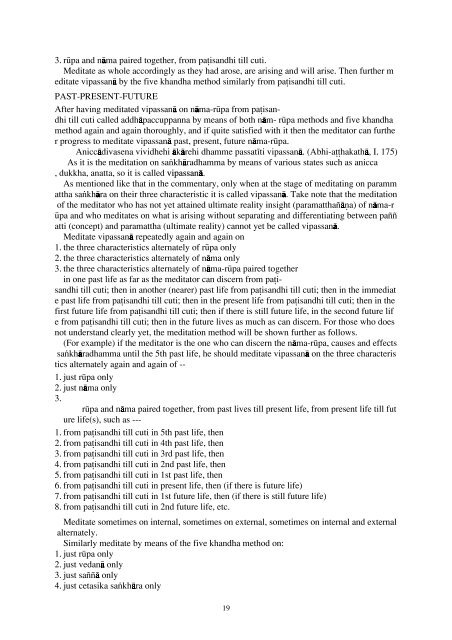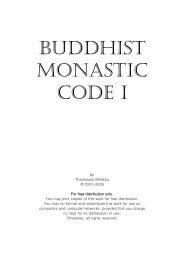Vipassana Kammatthana.pdf
Vipassana Kammatthana.pdf
Vipassana Kammatthana.pdf
You also want an ePaper? Increase the reach of your titles
YUMPU automatically turns print PDFs into web optimized ePapers that Google loves.
3. rËpa and nåma paired together, from pa isandhi till cuti.<br />
Meditate as whole accordingly as they had arose, are arising and will arise. Then further m<br />
editate vipassanå by the five khandha method similarly from pa isandhi till cuti.<br />
PAST-PRESENT-FUTURE<br />
After having meditated vipassanå on nåma-rËpa from pa isandhi<br />
till cuti called addhåpaccuppanna by means of both nåm- rËpa methods and five khandha<br />
method again and again thoroughly, and if quite satisfied with it then the meditator can furthe<br />
r progress to meditate vipassanå past, present, future nåma-rËpa.<br />
Aniccådivasena vividhehi åkårehi dhamme passat¥ti vipassanå. (Abhi-a hakathå, I. 175)<br />
As it is the meditation on sa∫khåradhamma by means of various states such as anicca<br />
, dukkha, anatta, so it is called vipassanå.<br />
As mentioned like that in the commentary, only when at the stage of meditating on paramm<br />
attha sa∫khåra on their three characteristic it is called vipassanå. Take note that the meditation<br />
of the meditator who has not yet attained ultimate reality insight (paramatthañåˆa) of nåma-r<br />
Ëpa and who meditates on what is arising without separating and differentiating between paññ<br />
atti (concept) and paramattha (ultimate reality) cannot yet be called vipassanå.<br />
Meditate vipassanå repeatedly again and again on<br />
1. the three characteristics alternately of rËpa only<br />
2. the three characteristics alternately of nåma only<br />
3. the three characteristics alternately of nåma-rËpa paired together<br />
in one past life as far as the meditator can discern from pa isandhi<br />
till cuti; then in another (nearer) past life from pa isandhi till cuti; then in the immediat<br />
e past life from pa isandhi till cuti; then in the present life from pa isandhi till cuti; then in the<br />
first future life from pa isandhi till cuti; then if there is still future life, in the second future lif<br />
e from pa isandhi till cuti; then in the future lives as much as can discern. For those who does<br />
not understand clearly yet, the meditation method will be shown further as follows.<br />
(For example) if the meditator is the one who can discern the nåma-rËpa, causes and effects<br />
sa∫khåradhamma until the 5th past life, he should meditate vipassanå on the three characteris<br />
tics alternately again and again of --<br />
1. just rËpa only<br />
2. just nåma only<br />
3.<br />
rËpa and nåma paired together, from past lives till present life, from present life till fut<br />
ure life(s), such as ---<br />
1. from pa isandhi till cuti in 5th past life, then<br />
2. from pa isandhi till cuti in 4th past life, then<br />
3. from pa isandhi till cuti in 3rd past life, then<br />
4. from pa isandhi till cuti in 2nd past life, then<br />
5. from pa isandhi till cuti in 1st past life, then<br />
6. from pa isandhi till cuti in present life, then (if there is future life)<br />
7. from pa isandhi till cuti in 1st future life, then (if there is still future life)<br />
8. from pa isandhi till cuti in 2nd future life, etc.<br />
Meditate sometimes on internal, sometimes on external, sometimes on internal and external<br />
alternately.<br />
Similarly meditate by means of the five khandha method on:<br />
1. just rËpa only<br />
2. just vedanå only<br />
3. just saññå only<br />
4. just cetasika sa∫khåra only<br />
19






